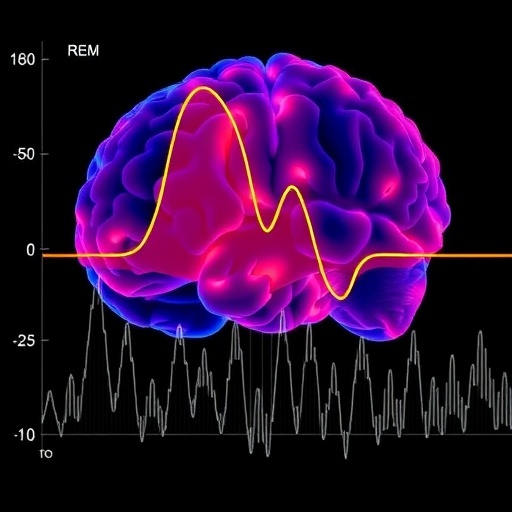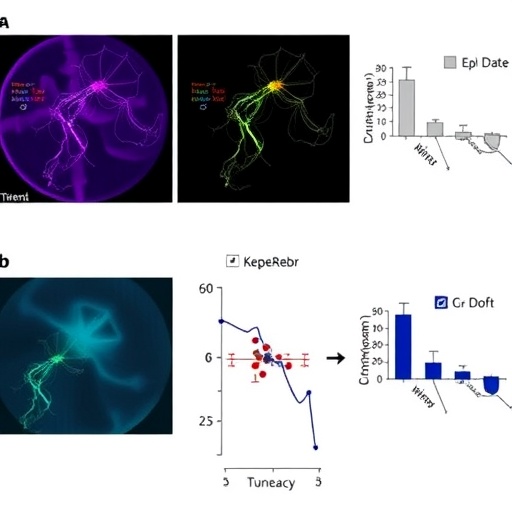In a groundbreaking study poised to redefine early diagnostic approaches for neurodegenerative disorders, researchers have identified the electroencephalogram (EEG) alpha peak frequency as a potent biomarker signaling the severity of cognitive impairment in individuals suffering from isolated REM sleep behavior disorder (iRBD). This discovery, detailed in a paper published in npj Parkinson’s Disease, offers unprecedented insight into the subtle neural dynamics preceding overt neurodegeneration, potentially allowing clinicians to predict and monitor cognitive decline with greater precision and lead times.
Isolated REM sleep behavior disorder, a parasomnia characterized by the loss of normal muscle paralysis during rapid eye movement (REM) sleep, frequently emerges as a harbinger of synucleinopathies such as Parkinson’s disease and dementia with Lewy bodies. While the motor manifestations are well-documented, the cognitive deterioration that accompanies or eventually overtakes many iRBD patients is less understood, in part due to the scarcity of reliable, non-invasive markers that track this decline in its subclinical stages. The EEG measure analyzed here, the alpha peak frequency, represents a promising window into the brain’s ongoing functional integrity.
Alpha rhythms, classically oscillating within the 8 to 12 Hz frequency band, have long been investigated in cognitive neuroscience as correlates of attention, memory, and overall cortical excitability. The specific frequency of the alpha peak—essentially the dominant oscillation within this range—has been shown to correlate with age-related cognitive changes, neuropsychiatric conditions, and even individual differences in intelligence and processing speed. Until now, however, its role in iRBD-related cognitive impairment was largely speculative.
.adsslot_PBYpXtazLm{ width:728px !important; height:90px !important; }
@media (max-width:1199px) { .adsslot_PBYpXtazLm{ width:468px !important; height:60px !important; } }
@media (max-width:767px) { .adsslot_PBYpXtazLm{ width:320px !important; height:50px !important; } }
ADVERTISEMENT
The team, led by Schopp, de Zeeuw, and Stotz, employed advanced EEG analytic techniques to systematically quantify the alpha peak frequency in a sizable cohort of iRBD patients. Their findings indicated a consistent downward shift in alpha peak frequency corresponding to increased severity of cognitive deficits, highlighting a robust neurophysiological signature that parallels clinical symptomatology. This frequency slowing appears to reflect a fundamental disruption in thalamocortical circuits integral to cognitive processing.
Technically, the alpha peak frequency was determined by power spectral density analyses computed from resting-state EEG recordings collected during wakefulness. By employing individualized frequency band definitions rather than fixed bands, the investigators ensured sensitivity to person-specific electrophysiological nuances, thereby enhancing the predictive power of the measure. Importantly, these alpha dynamics were extracted from multiple cortical sites, revealing a widespread slowing rather than localized focal abnormalities.
This frequency slowing suggests diminished synaptic synchronization and disruptions in neural network efficiency, both hallmarks commonly observed in neurodegenerative diseases. The alpha peak frequency hence offers a dynamic biomarker reflecting underlying pathological processes rather than static structural changes visible on neuroimaging. In clinical terms, this means EEG could serve as a cost-effective, repeatable tool to monitor disease progression or therapeutic response in iRBD patients, many of whom silently march toward cognitive decline.
The implications of these findings extend beyond iRBD, touching on broader neurodegenerative research where early detection remains a vexing challenge. Current diagnostic modalities—such as cerebrospinal fluid biomarkers and neuroimaging—are either invasive, expensive, or not widely accessible. EEG, by contrast, is a non-invasive, relatively inexpensive technique already implemented in many clinical settings, making it ideally suited for widespread screening and longitudinal monitoring if validated in larger populations.
Furthermore, the dynamic nature of EEG allows for the potential integration of real-time monitoring strategies or even at-home diagnostic adjuncts using portable EEG devices, democratizing access to neurophysiological diagnostics. This could catalyze a paradigm shift in preventive neurology, where interventions might be tailored according to electrophysiological markers indicating impending cognitive decline, potentially delaying or even halting progression through early treatment.
The study also underscores the importance of dissecting the electrophysiological underpinnings of sleep-related disorders, traditionally studied predominantly for their sleep architecture abnormalities and motor manifestations. By elucidating the complex interplay between REM sleep dysfunction and cortical oscillatory dynamics, this research suggests a pathophysiological continuum linking sleep disturbances with impending neurodegeneration, mediated by altered network synchrony.
Critically, while reduced alpha peak frequency reliably paralleled cognitive severity in iRBD, the causative mechanisms remain to be fully elucidated. Whether this slowing stems from neurochemical changes, synaptic pruning, or alterations in thalamic pacemaker function is an open question. Future studies integrating multimodal neurophysiology with molecular imaging and neuropathology will be essential to decode these mechanistic layers, potentially revealing novel therapeutic targets.
Moreover, the researchers emphasize that alpha peak frequency measurements should be contextualized within a multimodal diagnostic framework, combining genetic risk profiling, cognitive testing, and other biomarker assessments. Such integrated approaches promise to refine risk stratification, offering personalized prognoses that can guide clinical decision-making with greater confidence.
While promising, the translation of these findings into clinical routine requires addressing practical challenges, including standardizing EEG acquisition protocols, validating normative datasets across diverse populations, and establishing longitudinal normative ranges that account for age, sex, and comorbidities. The advancement of machine learning algorithms capable of automated, unbiased EEG feature extraction could accelerate this process, facilitating rapid clinical deployment.
As interest grows in neurodegenerative prodromal phases, this study reinforces the critical role electrophysiological biomarkers play as harbingers of cognitive dysfunction well before clinical dementia appears. Their ability to provide a snapshot of brain functional integrity renders them indispensable in the evolving landscape of neurology, where early intervention remains the best hope to alter disease trajectories.
In sum, the identification of EEG alpha peak frequency as a marker of cognitive impairment severity in isolated REM sleep behavior disorder not only advances our understanding of iRBD pathophysiology but also heralds a new era in non-invasive neurodiagnostics. This biomarker bridges the gap between classical polysomnography and cognitive assessment, offering a nuanced, dynamic picture of brain health and disease progression.
As the global burden of neurodegenerative disease escalates, innovations like these bring hope that earlier, more accurate detection coupled with targeted interventions can eventually slow or prevent the devastating cognitive decline that robs millions of their autonomy and dignity. The convergence of neurophysiology, sleep medicine, and cognitive neuroscience showcased in this research exemplifies the multidisciplinary collaboration needed to tackle one of the 21st century’s greatest medical challenges.
The innovative approach taken by Schopp and colleagues signals a crucial step forward, translating subtle brainwave signatures into actionable clinical insights. Such advances are instrumental in moving the field beyond symptom management toward predictive neurology — a future wherein neurodegeneration can be anticipated and mitigated rather than merely endured.
Subject of Research: Cognitive impairment biomarkers in isolated REM sleep behavior disorder
Article Title: EEG alpha peak frequency: cognitive impairment severity marker in isolated REM sleep behavior disorder
Article References:
Schopp, S., de Zeeuw, J., Stotz, S. et al. EEG alpha peak frequency: cognitive impairment severity marker in isolated REM sleep behavior disorder. npj Parkinsons Dis. 11, 185 (2025). https://doi.org/10.1038/s41531-025-01059-z
Image Credits: AI Generated
Tags: biomarkers for neurodegenerative disorderscognitive decline in REM sleep disordercognitive impairment monitoringcognitive neuroscience and EEG analysisEEG alpha peak frequencyisolated REM sleep behavior disorderneural dynamics in cognitive impairmentneurodegeneration predictionnon-invasive cognitive decline markersParkinson’s disease early diagnosisREM sleep behavior disorder symptomssynucleinopathies and cognitive decline





